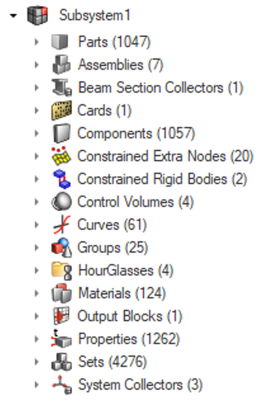Create Subsystems
To create subsystems, you can use drag-and-drop across browsers or the Organize functionality. Make sure the Subsystem Browser, the Model Browser, and the Part Browser are open at the same time.
- In the Subsystem Browser, right-click and select from the context menu.
- Drag and drop a selection from another browser into Subsystem Browser white space (Model Browser, Entity Specific views, Part Browser, and Reference Browser are all supported).

Figure 1.
Subsystems and Includes
There are special rules when working with Subsystems related to Includes. The first subsystem in your model will always be the "Model" subsystem. This is the subsystem connected to the "Main Include". When creating a new Subsystem, it will also create an Include. All entities moved into a Subsystem will be moved to the Include. The Subsystem always has one linked include and contents of the include and subsystem will always be in sync.
Subsystems support a hierarchy. If you have a hierarchy of Includes and drag the parent Include to the Subsystem Browser in order to create a Subsystem, all nested Includes become nested Subsystems, creating a one-to-one mapping of Includes and Subsystems.
Subsystems can easily be created from an existing Include structure. If you drag and drop multiple Includes into the Subsystem Browser white space, it creates one Subsystem per Include, quickly converting an Include structure into a Subsystem one.